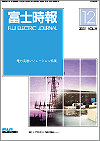Home > About Fuji Electric > Research & Development > Technical Intelligence > Fuji Electric Journal > Fuji Electric Journal
FUJI ELECTRIC JOURNAL 2001 Vol.74-No.12
 |
Electric Power System Solutions |
An Overview of Recent Solutions for Power System Control
Motofumi Matsumura, Kazuhiro Oohashi, Naoto Kobayashi
The power market deregulation and environmental problems have caused various needs in the power distribution system industry. This paper describes Fuji Electric's technical seeds and solutions to meet these needs and its attitude for the future. Utilizing technical seeds so far cultivated, such as open distributed technology for economical, flexible system/distribution control, highly reliable hardware technology for protective relays, power electronics and system analysis technology, we cope with anticipated needs, such as advanced information systems, high value-added services, flexible power quality, and reduction in the life cycle cost of power distribution systems.
Solutions to Various Problems of Electric Power Quality
Kazunari Komatsugi
Distributed power sources such as generators installed by suppliers other than utilities and power supply with new energy have diffused and enlarged in the power system. Herewith, factors that degrade power quality have increased latently. Against this trend, users themselves are required to install equipment to maintain or improve power quality. This paper describes an outline of measures to be taken by users, devices for power quality maintenance/improvement such as momentary voltage drop or power failure, reactive power, and harmonic current compensation with an outline of their operation, and a configuration example of discriminative power supply on the user side.
Analysis Technology of a Power System with Distributed Generators
Yosuke Nakanishi, Takehiko Kojima, Shinsuke Nii
Distributed generators are superior in regard to energy consumption and environmental problems and many of them will be connected to the power system in the future. In the power system connected with many and unspecified small-scale generators, power flow not through the load-dispatching command is generated. Also, the coordination of the former generators with distributed generators against faults in the power system is required. This paper reviews problems in connecting distributed generators to structure a more efficient power system taking distributed sources into consideration, and describes power system analysis technology required in these analyses.
"Customer Solution" for Electric Power Companies
Jinpei Kuwayama, Shinichiro Bika
Being backed by the deregulation, electric power companies are strengthening or commercializing services for customers. Fuji Electric regarded such trends of the service industry as a market, and planned a model for customer solution business mainly supported by energy saving solution, power quality solution, and value-added services. The customer solution business is characterized by the business style in which the latest information technology, analysis technology, and optimization technology are fused with a set of Fuji Electric's articles, taking the advantage of electric power company's infrastructure, etc.
Application of Optimization Techniques to Power Systems
- A New Optimization Technique, Meta-Heuristics -
Shinichi Takayama, Naoki Hayashi, Yoshikazu Fukuyama
Expert systems and fuzzy techniques have practically and successfully applied in power systems to consider various operational rules. However, these methods ensure appropriate solutions only in cases where the method was verified in advance. On the contrary, meta-heuristics (MH) can easily handle operational rules and generate optimal or appropriate solutions in any case. This paper summarizes Fuji Electric's recent application of MH to power systems.
Advanced Support Functions for Power System Operation
Tokuhei Uehara, Naotaka Miyamura, Satoru Takahashi
This paper describes Fuji Electric's efforts and achievements with regard to support systems for power system operation. An advanced, practical support function for system operation based on system analysis technology, particularly the optimal power flow via interior point nonlinear programming method is proposed. In addition, a trend of new support system construction using Internet Protocol technology and object-oriented software development technology is shown. The proposed support functions will serve to make power system operation flexible and effective.
Linux and Open Architecture Application to the Wide-Area Web System for Utilities
Yasushi Shikagawa, Shinji Hayashi, Hiroshi Hosoda
The wide-area Web system for utilities aims at taking fault and system information transmitted from the monitor and control system into the data base and publicizing it on the intranet. Because Web servers for publication are distributed on a wide area and need to be connected with each other to exchange information, the Web integration of a UNIX server as the core and many personal computer servers existing together was required. This paper describes the reason why Linux was selected for the server OS in structuring this system and the open technology used for suppor ting it.
New Tele-Control Equipment "STC-3500 Series"
Fumio Miyamoto, Hiroyuki Wada, Tatsuo Suzuki
In regard to tele-control equipment for power systems, high-performance hardware has been desired with the increase in information volume and in transmission speed. On the other hand, reduction in size and power consumption is also strongly desired. Fuji Electric has developed new tele-control equipment STC-3500 Series to meet these market requirements. This paper describes the featur es of the newly developed components for this series and an application example of the product.
New Control, Protection and Monitoring Technologies for Improving Substation Efficiency
Toshio Matsumoto, Takashi Yoshida, Masanori Toi
Control, protection, and monitoring systems play an important role in improving substation efficiency. Today substation systems are classified into station-level, bay-level, and pr ocess-level systems. With regard to each level substation equipment, this paper describes concrete technical trends, trends of user needs from the social and economical point of view, as well as Fuji Electric's achievements, future policy, and problems in carrying out the policy.

